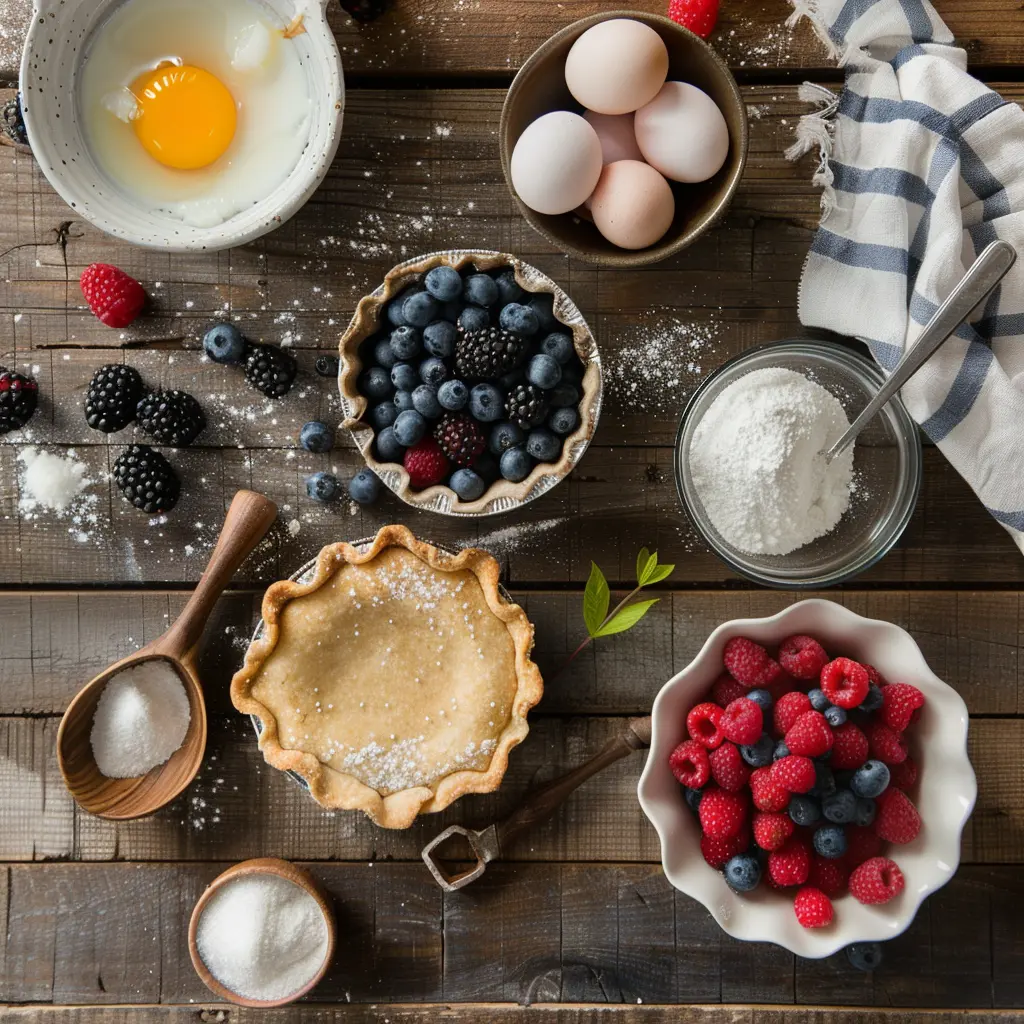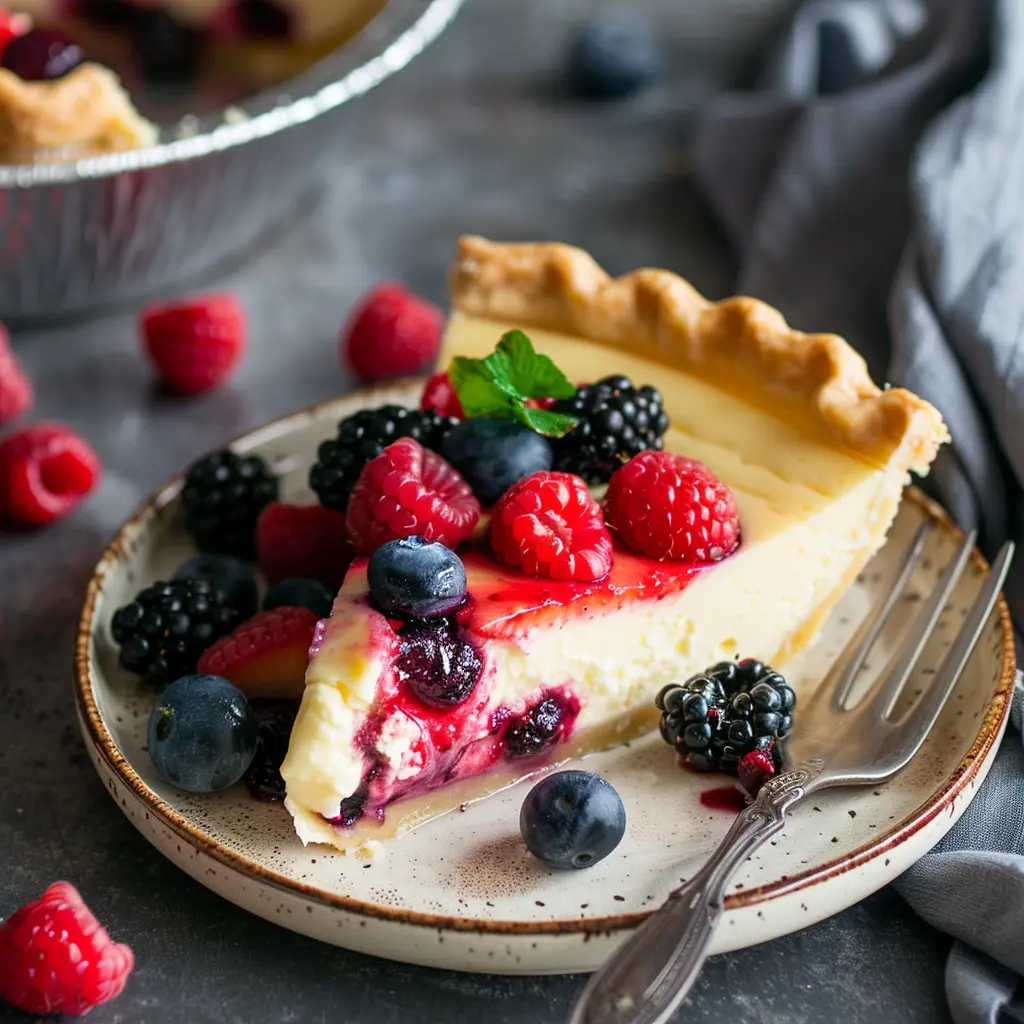In this article, we’ll dive into a delightful Berry Custard Pie that balances sweet custard with fresh berries—perfect for family gatherings or weekend treats. We’ll start with a cozy story behind this favorite, then walk through how to know when custard pie is done, how to avoid a runny filling, and how to keep it from overcooking. You’ll also find my favorite tips for checking pie doneness and what makes a custard pie so comforting. Plus, we’ll weave in helpful links to related recipes like a no‑bake strawberry cheesecake or a peach tart for more dessert inspiration.
The Story behind Berry Custard Pie
I still remember the first time I created this berry custard pie for a summer potluck—brimming with tart raspberries, sweet blackberries, and velvety custard in a golden crust. It all began when I dug up that old family recipe and thought, “What if I folded in fresh berries for a pop of summer flavor?” That decision turned a plain custard into something celebratory and bright, perfect for sharing. The kitchen filled with warm, nostalgic aromas, and everyone asked for seconds—so I knew I’d stumbled upon something special.
Growing up, I spent hours in my mom’s kitchen stirring custards and sneaking tastes from the cooling pot. That playful tradition lives on in this pie. What I love most about this berry custard pie is how it captures the essence of homemade comfort—simple ingredients, easy steps, and a flavor that feels like home. Whether you call it a berry twist on a classic custard pie or simply custard pie with fresh fruit, it brings that same sense of nostalgia and warmth.
In this section, we’ll share the berry custard pie story, highlight why it works so well for summer entertaining, and tease the helpful tips coming up—like how to tell if a custard pie is done without overcooking, or what to do if your filling turns out runny. We’ll also link to my no‑bake strawberry crunch cheesecake and creamy no‑bake peach tart from the dessert collection so you can explore more fruit‑filled treats while we dive deeper into custard perfection.
Mastering Berry Custard Pie Doneness

How to tell when your berry custard pie is perfectly done
Knowing when your custard pie is done can feel tricky, but you’ve got reliable tricks to make it foolproof. First, look for a slight jiggle in the center—if the edges are set but the very center still moves gently when you shake the pie pan, it’s ready. This soft wobble means the custard will continue to bake and set as it cools. Don’t wait for it to look firm; that can lead to a dry, overcooked filling.
Another reliable test is the toothpick method. Insert a clean toothpick about an inch from the center; if it comes out mostly clean with a few moist crumbs, your custard pie is done. This method mirrors the guidance used for classic custard and pumpkin pies alissarecipes.com. Resist the urge to fill a deep wiggly custard; aiming for that delicate jiggle ensures creamy results.Use the “jiggle test” or insert a toothpick near the center—just like recommended in King Arthur Baking’s guide to custard pie baking, which explains the science of perfect doneness.
Common doneness issues and easy solutions
Even when done, custard pies can feel underwhelming if you overcook them. Overbaking makes the edges tough and the filling crumbly. To avoid this, begin checking doneness with the jiggle and toothpick tests at about 30–35 minutes. Remember, the pie continues to firm up during cooling, so it’s better to slightly undercook than overdo it .
If you notice cracks or separation between the custard and crust, that’s a sign you pushed past perfection. Try lowering your oven temperature by 25 °F and extend baking time by a few minutes next time. And always rest your pie for at least 20 minutes after baking—cooling is key. It gives the custard time to stabilize without losing moisture, ensuring a silky, indulgent texture.

Berry Custard Pie Recipe – 5 Easy Steps to Creamy Perfection
- Total Time: 2 hours 50 minutes (including cooling)
- Yield: 8 servings 1x
- Diet: Vegetarian
Description
This berry custard pie recipe is a creamy, fruity dessert made with fresh berries, vanilla custard, and a flaky crust. A simple yet elegant pie perfect for any occasion.
Ingredients
1 pre-baked pie crust
3 large eggs
1 cup granulated sugar
1 ½ cups whole milk
½ cup heavy cream
1 tsp vanilla extract
1 tbsp cornstarch
1 ½ cups mixed berries (fresh)
1 tbsp flour (for coating berries)
Instructions
1. Preheat oven to 350°F (175°C).
2. In a large bowl, whisk eggs and sugar until smooth.
3. Add milk, cream, vanilla, and cornstarch. Mix until fully combined.
4. Toss berries with flour to prevent excess moisture.
5. Pour custard mixture into the pre-baked crust.
6. Gently fold in coated berries.
7. Bake for 35–40 minutes until edges are set and center slightly jiggles.
8. Cool for 2–3 hours before slicing.
9. Refrigerate overnight for best texture.
Notes
Use fresh berries for best results.
Do not skip cooling time—custard sets as it cools.
Tossing berries in flour prevents runny filling.
- Prep Time: 10 minutes
- Cook Time: 40 minutes
- Category: Dessert
- Method: Baking
- Cuisine: American
Nutrition
- Serving Size: 1 slice
- Calories: 310
- Sugar: 22g
- Sodium: 160mg
- Fat: 18g
- Saturated Fat: 10g
- Unsaturated Fat: 7g
- Trans Fat: 0g
- Carbohydrates: 30g
- Fiber: 2g
- Protein: 5g
- Cholesterol: 95mg
Keywords: berry custard pie, homemade custard pie, easy berry pie
Troubleshooting Runny Berry Custard Pie
Why your berry custard pie might turn out runny
One of the most common issues with any custard pie—especially a berry custard pie—is a runny filling. The problem usually starts with underbaking or not letting the pie rest and chill properly. Even if the center jiggles just right in the oven, slicing it too soon will cause the custard to spill. This happens because custard continues setting during cooling. For perfect consistency, always chill your pie for at least 2–3 hours before serving.
Another culprit? Too much liquid. Berries release juice while baking, which can thin out your custard. One smart trick is to gently toss the berries in cornstarch or flour before adding them to the filling. This helps absorb excess moisture and keeps the texture balanced. Also, avoid frozen berries unless they’re thawed and well-drained. Frozen fruit contains more water and often causes soggy, runny results.
Preventing watery filling in berry custard pie
To prevent runny custard, follow a few simple tips: always prebake (blind bake) your crust, especially if you’re using a homemade or store-bought pastry shell. A crisp bottom layer helps prevent sogginess. If your oven temperature fluctuates, use an oven thermometer to ensure it bakes steadily around 350°F.
Don’t forget resting time either. Even the best custard pie needs time to firm up before slicing. For ultra-clean slices, refrigerate overnight. You can cover it loosely with plastic wrap once it’s cooled to room temperature to keep the top from drying out.Toss the berries in cornstarch to absorb extra moisture—a common trick noted by America’s Test Kitchen, which helps keep custard firm even when using fresh fruit.
Want a custard that never runs?
If you’re interested in a guaranteed no-run dessert, try my Mini Lemon Cheesecakes—they set in the fridge and hold their shape beautifully. Or explore the Easy Vanilla Flan for a silky, chilled custard alternative that won’t collapse on the plate.
Describing Berry Custard Pie Like a Pro
How to describe the taste and texture of berry custard pie
A great berry custard pie delivers a harmony of textures and flavors that’s both nostalgic and fresh. The custard is silky and rich, lightly sweetened with a hint of vanilla or citrus zest. It melts in your mouth with every bite—never gritty or rubbery, but smooth and creamy. Now, add juicy bursts of tart raspberries, sweet strawberries, or plump blueberries, and you’ve got a balance that wakes up the senses.
The crust adds structure and contrast: buttery, golden, and just slightly crisp. The pie’s scent is comforting—think warm vanilla, baked fruit, and a soft caramelized edge where the custard meets the crust. It’s light enough to enjoy after a big meal but indulgent enough to serve at a celebration.
Making your berry custard pie unforgettable
To make your pie stand out, experiment with flavor additions like lemon zest in the custard, a graham cracker crust for texture, or a touch of almond extract. A berry glaze on top (made by simmering berries, sugar, and lemon juice) adds both shine and a pop of tangy flavor. Garnish with fresh berries or a dusting of powdered sugar for a beautiful finish.
What makes a custard pie like this one so special is its versatility. It feels equally at home at a summer barbecue, a holiday dinner, or just a cozy night in with a cup of tea. The combination of creamy and fruity is timeless—and with the right bake and chill time, it’s practically foolproof.
More fruit-meets-custard ideas
You might also enjoy the Strawberry Crunch Cheesecake for a nostalgic twist on fruit and cream, or the elegant No-Bake Peach Tart when you’re short on oven space.
FAQ Section
Can you overcook custard pie?
Yes. Overcooking causes the custard to curdle and become grainy. Always look for a slight jiggle in the center and follow cooling instructions.
What are 2 ways to check a custard pie to know if it is done?
Use the “jiggle test” (center jiggles, edges are set) or insert a toothpick near the center—if it comes out with moist crumbs, it’s done.
Why is my custard pie runny?
Runny custard happens from underbaking or excess moisture from berries. Chill the pie thoroughly and use cornstarch with berries to reduce liquid.
How do you describe custard pie?
Custard pie is creamy, lightly sweet, and silky with a firm but smooth texture. Berry versions offer tart, fruity bursts and a buttery crust.
Conclusion
Berry custard pie is one of those desserts that feels like a warm hug—simple, comforting, and unforgettable. With its silky smooth filling, juicy fresh berries, and flaky crust, it’s the kind of pie that disappears quickly at any table. Whether you’re baking it for a special occasion or just a sweet moment at home, this recipe offers both flavor and nostalgia.
By learning how to check doneness, prevent runny fillings, and describe its delightful texture, you’re well on your way to mastering this classic. Want more inspiration? Explore similar recipes like our Strawberry Crunch Cheesecake or Easy Peach Tart to keep the sweet ideas flowing.

